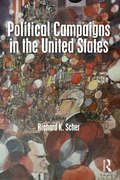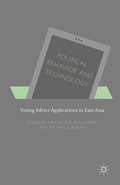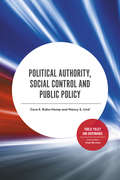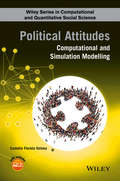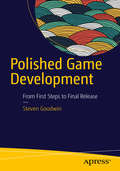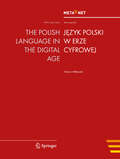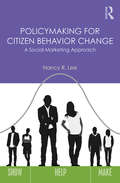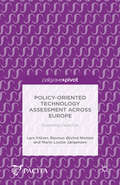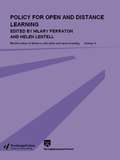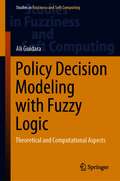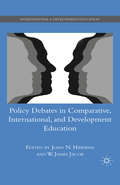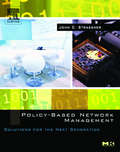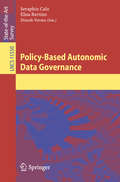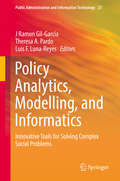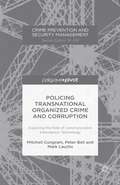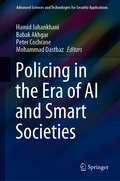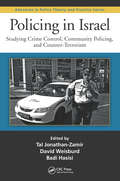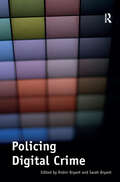- Table View
- List View
Political Campaigns in the United States
by Richard K. ScherA Choice Highly Recommended Title—January 2017 This book is an interpretive analysis of political campaigns in America: instead of focusing on how campaigns are designed and run, it investigates the role campaigns play in our American politics, and the close symbiosis between campaigns and those politics. The text examines how campaigns are an important manifestation of how we "do" politics in this country. Hallmarks of this text include: showing how campaigns can undermine our democracy and asking how democratic they—and by extension, our politics--really are; demonstrating that the ability of the media to accurately, fairly, and deeply report on campaigns has been severely compromised, both because of the growing "distance" between campaigns and media outlets and because of the structure of "Big Media" corporate ownership and its tight relationship to "Big Money." It asks important questions about the media including: How do the media, reporters in particular, cover campaigns? What pressures and forces shape what and how they present campaigns? What is the impact of the ever-increasing chasm separating campaigns and the media? How does the close tie between corporate mainstream media and Super PAC money affect campaign coverage? How does the ability of campaigns and media to segment voters into ever-smaller slices influence how campaigns are covered? tracking the continuing growth of unregulated, private, unaccountable "dark money" in campaigns as a threat to our democratic elections and politics. Democracy rests fundamentally on transparency and accountability – sunlight – and our campaign laws and norms now allow and encourage exactly the opposite, largely because of decisions by the United States Supreme Court.
Political Campaigns in the United States
by Richard K. ScherA Choice Highly Recommended Title—January 2017 This book is an interpretive analysis of political campaigns in America: instead of focusing on how campaigns are designed and run, it investigates the role campaigns play in our American politics, and the close symbiosis between campaigns and those politics. The text examines how campaigns are an important manifestation of how we "do" politics in this country. Hallmarks of this text include: showing how campaigns can undermine our democracy and asking how democratic they—and by extension, our politics--really are; demonstrating that the ability of the media to accurately, fairly, and deeply report on campaigns has been severely compromised, both because of the growing "distance" between campaigns and media outlets and because of the structure of "Big Media" corporate ownership and its tight relationship to "Big Money." It asks important questions about the media including: How do the media, reporters in particular, cover campaigns? What pressures and forces shape what and how they present campaigns? What is the impact of the ever-increasing chasm separating campaigns and the media? How does the close tie between corporate mainstream media and Super PAC money affect campaign coverage? How does the ability of campaigns and media to segment voters into ever-smaller slices influence how campaigns are covered? tracking the continuing growth of unregulated, private, unaccountable "dark money" in campaigns as a threat to our democratic elections and politics. Democracy rests fundamentally on transparency and accountability – sunlight – and our campaign laws and norms now allow and encourage exactly the opposite, largely because of decisions by the United States Supreme Court.
Political Behavior and Technology: Voting Advice Applications in East Asia
by Da-Chi Liao Boyu Chen Michael J. Jensen Colin W. PritchardThis volume is a study of the emergence and consequences of computerized voting advice applications (VAAs) in Japan, South Korea, and Taiwan. In contrast to the European experience of VAAs simplifying vote choices, this research shows that VAAs in East Asia may increase their complexity.
Political Authority, Social Control and Public Policy (Public Policy and Governance)
by Cara E. Rabe-Hemp Nancy S. LindPolitical movements and citizens across the globe are increasingly challenging the traditional ways in which political authorities and governing bodies establish and maintain social control. This edited collection examines the intersections of social control, political authority and public policy. Each chapter provides an important insight into the key elements needed to understand the role of governance in establishing and maintaining social control through law and public policymaking. Close attention is paid to the roles of surveillance and dissent as tools for both establishing and disrupting the social control of political institutions. This collection examines the vast implications of increased participation in governance by citizens through dissent, revealing the ways in which this represents both a disruption of social control and a mechanism for increased accountability through surveillance and media. Through its examination of issues such as police militarization, police legitimacy, religion and the state, immigration, mental health policy, privacy and surveillance, and mass media and social control in a post-truth environment, this collection will prove invaluable for researchers, policy makers and practitioners alike.
Political Authority, Social Control and Public Policy (Public Policy and Governance)
by Nancy S. Lind Cara E. Rabe-HempPolitical movements and citizens across the globe are increasingly challenging the traditional ways in which political authorities and governing bodies establish and maintain social control. This edited collection examines the intersections of social control, political authority and public policy. Each chapter provides an important insight into the key elements needed to understand the role of governance in establishing and maintaining social control through law and public policymaking. Close attention is paid to the roles of surveillance and dissent as tools for both establishing and disrupting the social control of political institutions. This collection examines the vast implications of increased participation in governance by citizens through dissent, revealing the ways in which this represents both a disruption of social control and a mechanism for increased accountability through surveillance and media. Through its examination of issues such as police militarization, police legitimacy, religion and the state, immigration, mental health policy, privacy and surveillance, and mass media and social control in a post-truth environment, this collection will prove invaluable for researchers, policy makers and practitioners alike.
Political Attitudes: Computational and Simulation Modelling (Wiley Series in Computational and Quantitative Social Science)
by Camelia Florela VoineaPolitical Science has traditionally employed empirical research and analytical resources to understand, explain and predict political phenomena. One of the long-standing criticisms against empirical modeling targets the static perspective provided by the model-invariant paradigm. In political science research, this issue has a particular relevance since political phenomena prove sophisticated degrees of context-dependency whose complexity could be hardly captured by traditional approaches. To cope with the complexity challenge, a new modeling paradigm was needed. This book is concerned with this challenge. Moreover, the book aims to reveal the power of computational modeling of political attitudes to reinforce the political methodology in facing two fundamental challenges: political culture modeling and polity modeling. The book argues that an artificial polity model as a powerful research instrument could hardly be effective without the political attitude and, by extension, the political culture computational and simulation modeling theory, experiments and practice. This book: Summarizes the state of the art in computational modeling of political attitudes, with illustrations and examples featured throughout. Explores the different approaches to computational modeling and how the complexity requirements of political science should determine the direction of research and evaluation methods. Addresses the newly emerging discipline of computational political science. Discusses modeling paradigms, agent-based modeling and simulation, and complexity-based modeling. Discusses model classes in the fundamental areas of voting behavior and decision-making, collective action, ideology and partisanship, emergence of social uprisings and civil conflict, international relations, allocation of public resources, polity and institutional function, operation, development and reform, political attitude formation and change in democratic societies. This book is ideal for students who need a conceptual and operational description of the political attitude computational modeling phases, goals and outcomes in order to understand how political attitudes could be computationally modeled and simulated. Researchers, Governmental and international policy experts will also benefit from this book.
Political Attitudes: Computational and Simulation Modelling (Wiley Series in Computational and Quantitative Social Science)
by Camelia Florela VoineaPolitical Science has traditionally employed empirical research and analytical resources to understand, explain and predict political phenomena. One of the long-standing criticisms against empirical modeling targets the static perspective provided by the model-invariant paradigm. In political science research, this issue has a particular relevance since political phenomena prove sophisticated degrees of context-dependency whose complexity could be hardly captured by traditional approaches. To cope with the complexity challenge, a new modeling paradigm was needed. This book is concerned with this challenge. Moreover, the book aims to reveal the power of computational modeling of political attitudes to reinforce the political methodology in facing two fundamental challenges: political culture modeling and polity modeling. The book argues that an artificial polity model as a powerful research instrument could hardly be effective without the political attitude and, by extension, the political culture computational and simulation modeling theory, experiments and practice. This book: Summarizes the state of the art in computational modeling of political attitudes, with illustrations and examples featured throughout. Explores the different approaches to computational modeling and how the complexity requirements of political science should determine the direction of research and evaluation methods. Addresses the newly emerging discipline of computational political science. Discusses modeling paradigms, agent-based modeling and simulation, and complexity-based modeling. Discusses model classes in the fundamental areas of voting behavior and decision-making, collective action, ideology and partisanship, emergence of social uprisings and civil conflict, international relations, allocation of public resources, polity and institutional function, operation, development and reform, political attitude formation and change in democratic societies. This book is ideal for students who need a conceptual and operational description of the political attitude computational modeling phases, goals and outcomes in order to understand how political attitudes could be computationally modeled and simulated. Researchers, Governmental and international policy experts will also benefit from this book.
Political Advertising in the United States
by Michael M. Franz Travis N. Ridout Erika Franklin FowlerPolitical Advertising in the United States examines the volume, distribution, content, and effects of political advertising in congressional and presidential elections. The book considers the role of television ads using extensive data on ad airings on local broadcast stations. It also analyzes newly available data on paid digital ads, including ads on Facebook, Instagram, Google, and YouTube. The book covers the role of outside groups in airing ads, including the rise of dark money groups and gaps in existing federal campaign finance laws around transparency of outside group spending. The authors consider how ad sponsors design and target ads. They also review the positive and negative implications of an electoral system where billions are spent on paid advertising. With detailed analysis of presidential and congressional campaign ads and discussion questions in each chapter, this accessibly written book is a must-read for students, scholars, and practitioners who want to understand the ins and outs of political advertising. New to the Second Edition • Covers the spending, content, and tone of political advertising in the 2016 and 2020 presidential elections and the 2018 midterms, looking ahead to 2022 and 2024. • Addresses the interference of foreign actors in elections and their connection to political advertising. • Expands the discussion of digital political advertising and incorporates this topic into every chapter. • Adds a new chapter specifically addressing digital ad content and spending. • Includes data from the Facebook, Google, and Snapchat ad libraries and explores the role of these companies in regulating the sale of political advertising. • Incorporates new data on the effects of race and gender in advertising, including what is known about the way in which advertising may activate prejudicial attitudes.
Political Advertising in the United States
by Michael M. Franz Travis N. Ridout Erika Franklin FowlerPolitical Advertising in the United States examines the volume, distribution, content, and effects of political advertising in congressional and presidential elections. The book considers the role of television ads using extensive data on ad airings on local broadcast stations. It also analyzes newly available data on paid digital ads, including ads on Facebook, Instagram, Google, and YouTube. The book covers the role of outside groups in airing ads, including the rise of dark money groups and gaps in existing federal campaign finance laws around transparency of outside group spending. The authors consider how ad sponsors design and target ads. They also review the positive and negative implications of an electoral system where billions are spent on paid advertising. With detailed analysis of presidential and congressional campaign ads and discussion questions in each chapter, this accessibly written book is a must-read for students, scholars, and practitioners who want to understand the ins and outs of political advertising. New to the Second Edition • Covers the spending, content, and tone of political advertising in the 2016 and 2020 presidential elections and the 2018 midterms, looking ahead to 2022 and 2024. • Addresses the interference of foreign actors in elections and their connection to political advertising. • Expands the discussion of digital political advertising and incorporates this topic into every chapter. • Adds a new chapter specifically addressing digital ad content and spending. • Includes data from the Facebook, Google, and Snapchat ad libraries and explores the role of these companies in regulating the sale of political advertising. • Incorporates new data on the effects of race and gender in advertising, including what is known about the way in which advertising may activate prejudicial attitudes.
Polished Game Development: From First Steps to Final Release
by Steven GoodwinLearn the things you need for a complete game, such as translations and tutorials, and improve the things you've already written to raise their standard to a professional level. This is a practical guide covering every discipline: art, music, writing, and code. In the case of the latter, code examples are included to demonstrate how to implement functionality to make the game shine.Polished Game Development acts as a comprehensive checklist of everything your game should, and should not, do, in order to be as good as it possibly can. It is more than just a book on theoretical game design principles. Explains the difference between a pet project, and a professional one.Covers how to test for the problems and bugs you don't know you'll have.Details simple, but effective, visual improvements that can be done with very little effort.Regardless of platform (web, mobile, or console), or language (C++, C#, JavaScript) there is a wealth of common (and specific) tips within these pages that will enable you to make the most professional games you can.What You Will LearnLearn what essential elements are often missedStay on-brand, visually and verballyUse audio to enhance your gameImprove game balanceTest effectivelyWho This Book Is ForGame developers looking for a guide and checklist on how to get their game finished to the highest possible standards. They will know how to write a game, and get it released, but not necessarily how to make it shine. They will be professional developers, indies, university students and graduates.
The Polish Language in the Digital Age (White Paper Series)
by Georg Rehm Hans UszkoreitThis white paper is part of a series that promotes knowledge about language technology and its potential. It addresses educators, journalists, politicians, language communities and others. The availability and use of language technology in Europe varies between languages. Consequently, the actions that are required to further support research and development of language technologies also differ for each language. The required actions depend on many factors, such as the complexity of a given language and the size of its community. META-NET, a Network of Excellence funded by the European Commission, has conducted an analysis of current language resources and technologies. This analysis focused on the 23 official European languages as well as other important national and regional languages in Europe. The results of this analysis suggest that there are many significant research gaps for each language. A more detailed expert analysis and assessment of the current situation will help maximise the impact of additional research and minimize any risks. META-NET consists of 54 research centres from 33 countries that are working with stakeholders from commercial businesses, government agencies, industry, research organisations, software companies, technology providers and European universities. Together, they are creating a common technology vision while developing a strategic research agenda that shows how language technology applications can address any research gaps by 2020.
Policymaking for Citizen Behavior Change: A Social Marketing Approach
by Nancy R. LeeSocial marketing is a discipline unfamiliar to many policymakers, often confused with the more frequently applied and studied fields of social media, behavioral economics, or social change. Social marketing is a growing field and methodology, however, that has been successfully applied to improve public health, prevent injuries, protect the environment, engage communities, and improve financial well-being. Policymaking for Citizen Behavior Change is designed to demonstrate the ways in which social marketing can be an effective and efficient tool to change citizens’ behavior, and how to advocate for and support its appropriate application. Providing a 10-Step Planning Model and examining a variety of social marketing cases and tools, including more than 40 success stories, Policymaking for Citizen Behavior Change is core reading for current policymakers, as well as all those studying and practicing social marketing, particularly in the public sector. It’s also worthwhile supplementary reading for those studying public policy, public administration, environmental justice, public health, and other programs on how to effect social change.
Policymaking for Citizen Behavior Change: A Social Marketing Approach
by Nancy R. LeeSocial marketing is a discipline unfamiliar to many policymakers, often confused with the more frequently applied and studied fields of social media, behavioral economics, or social change. Social marketing is a growing field and methodology, however, that has been successfully applied to improve public health, prevent injuries, protect the environment, engage communities, and improve financial well-being. Policymaking for Citizen Behavior Change is designed to demonstrate the ways in which social marketing can be an effective and efficient tool to change citizens’ behavior, and how to advocate for and support its appropriate application. Providing a 10-Step Planning Model and examining a variety of social marketing cases and tools, including more than 40 success stories, Policymaking for Citizen Behavior Change is core reading for current policymakers, as well as all those studying and practicing social marketing, particularly in the public sector. It’s also worthwhile supplementary reading for those studying public policy, public administration, environmental justice, public health, and other programs on how to effect social change.
Policy-Oriented Technology Assessment Across Europe: Expanding Capacities
by Lars Klüver Rasmus Øjvind Nielsen Marie Louise JørgensenThis book is open access under a CC-BY license. Policy-making to address grand challenges faces greater complexity than any previous project of modernization. Future scenarios are haunted by uncertainty and there is real ambivalence as to the values that policy should strive for. In this situation decision-makers look to research and innovation to provide answers and solutions. But neither can the great transitions ahead be planned by science, nor will conventional methods of innovation bring such transitions about. A turn to interactive governance is therefore underway with policy-makers and citizens becoming increasingly involved in processes of deliberating futures. Technology Assessment (TA) is the art of structuring such processes. TA goes beyond traditional expert policy analysis by systematically combining a multi-disciplinary evidence base with participatory approaches to policy deliberation. TA thus seeks to act as a hub for serious and transparent dialogue between policy, industry, science, and society about the challenges ahead and the available options for overcoming them responsibly. This volume offers an up-to-date account of the expansion of technology assessment capacities across new European member states. The contributions of this volume are written by leading European researchers and practitioners in technology assessment (TA) and are based on the PACITA (Parliaments and Civil Society in Technology Assessment) project.
Policy for Open and Distance Learning: World review of distance education and open learning Volume 4
by Helen Lentell Hilary PerratonPolicy for Open and Distance Learning considers the questions that planners and policy makers in open and distance learning need to address at any level of education.Starting by analysing the range of purposes for which open and distance learning is used, the book places the issues in context and examines experience in both the public and private sector. As well as discussing in detail new agenda set by new information and communication technologies, the book covers:* Inputs * Processes * Outcomes.The editors, Hilary Perraton and Helen Lentell, have drawn together an international team of contributors who have examined the varied roles of the new technologies as well as low-technology approaches to open and distance learning throughout the world.This book will be invaluable to policy makers in education and those planning or managing open and distance learning programmes. It will also be of interest to students and teachers of education and anyone concerned with comparative education.
Policy for Open and Distance Learning: World review of distance education and open learning Volume 4
by Hilary Perraton Helen LentellPolicy for Open and Distance Learning considers the questions that planners and policy makers in open and distance learning need to address at any level of education.Starting by analysing the range of purposes for which open and distance learning is used, the book places the issues in context and examines experience in both the public and private sector. As well as discussing in detail new agenda set by new information and communication technologies, the book covers:* Inputs * Processes * Outcomes.The editors, Hilary Perraton and Helen Lentell, have drawn together an international team of contributors who have examined the varied roles of the new technologies as well as low-technology approaches to open and distance learning throughout the world.This book will be invaluable to policy makers in education and those planning or managing open and distance learning programmes. It will also be of interest to students and teachers of education and anyone concerned with comparative education.
Policy Decision Modeling with Fuzzy Logic: Theoretical and Computational Aspects (Studies in Fuzziness and Soft Computing #405)
by Ali GuidaraThis book introduces the concept of policy decision emergence and its dynamics at the sub systemic level of the decision process. This level constitutes the breeding ground of the emergence of policy decisions but remains unexplored due to the absence of adequate tools. It is a nonlinear complex system made of several entities that interact dynamically. The behavior of such a system cannot be understood with linear and deterministic methods.The book presents an innovative multidisciplinary approach that results in the development of a Policy Decision Emergence Simulation Model (PODESIM). This computational model is a multi-level fuzzy inference system that allows the identification of the decision emergence levers.This development represents a major advancement in the field of public policy decision studies. It paves the way for decision emergence modeling and simulation by bridging complex systems theory, multiple streams theory, and fuzzy logic theory.
Policy Debates in Comparative, International, and Development Education (International and Development Education)
by John N. Hawkins And W. James JacobThe complementary areas of comparative, international, and development education occupy a critical part of the landscape in educational policy debates in a global context. This volume brings together a distinguished group of international scholars and practitioners who focus on key policy issues in a variety of national settings throughout the regions of Asia/Pacific, Africa, the Middle East, Europe, North America, and Latin America. The topics they address are critical for the future of education in a globalized context and include issues such as social justice, quality assurance, governance, access and equity, marketization, and the role of new media and technology, among others.
Policy-Based Network Management: Solutions for the Next Generation (ISSN)
by John StrassnerPolicy-Based Network Management (PBNM) systems enable business rules and procedures to be translated into policies that configure and control the network and its services. Those who manage network systems are aware that this approach can benefit both network management as well as the development of applications that use network services; however, the details surrounding these systems has been obscured by marketing hype, numerous acronyms, and theoretical complexities. Policy-Based Network Management: Solutions for the Next Generation cuts through the hype surrounding PBNM and makes it approachable for those who really need to understand what it has to offer. The author, founder of the IETF Policy Framework working group, discusses system requirements, information models, and system components for Policy-Based Management. He also provide practitioners with a resource for developing and/or incorporating PBNM systems. As network systems become larger and more complex, creating policies for them has become a crucial step in the management of network systems, and this book is a welcome addition to this exciting approach.* Presents a completely new approach to PBNM that unites the business, system, and implementation spheres.* As the basis for examples and discussion, uses the DEN-ng information model, an easy-to-understand open standard tied closely to eTOM and NGOSS.* Introduces the Ponder system, then examines Ponder extensions designed to enhance the structure of high-level policies and their application in a PBNM system.* Filled with examples illustrating how policies are most effectively used in a PBNM system and what new directions PBNM is likely to take.
Policy-Based Autonomic Data Governance (Lecture Notes in Computer Science #11550)
by Seraphin Calo Elisa Bertino Dinesh VermaAdvances in artificial intelligence, sensor computing, robotics, and mobile systems are making autonomous systems a reality. At the same time, the influence of edge computing is leading to more distributed architectures incorporating more autonomous elements. The flow of information is critical in such environments, but the real time, distributed nature of the system components complicates the data protection mechanisms. Policy-based management has proven useful in simplifying the complexity of management in domains like networking, security, and storage; it is expected that many of those benefits would carry over to the task of managing big data and autonomous systems. This book aims at providing an overview of recent work and identifying challenges related to the design of policy-based approaches for managing big data and autonomous systems. An important new direction explored in the book is to make the major elements of the system self-describing and self-managing. This would lead to architectures where policy mechanisms are tightly coupled with the system elements. In such integrated architectures, we need new models for information assurance, traceability of information, and better provenance on information flows. In addition when dealing with devices with actuation capabilities and, thus, being able to make changes to physical spaces, safety is critical. With an emphasis on policy-based mechanisms for governance of data security and privacy, and for safety assurance, the papers in this volume follow three broad themes: foundational principles and use-cases for the autonomous generation of policies; safe autonomy; policies and autonomy in federated environments.
Policy Analytics, Modelling, and Informatics: Innovative Tools for Solving Complex Social Problems (Public Administration and Information Technology #25)
by J Ramon Gil-Garcia Theresa A. Pardo Luis F. Luna-ReyesThis book provides a comprehensive approach to the study of policy analytics, modelling and informatics. It includes theories and concepts for understanding tools and techniques used by governments seeking to improve decision making through the use of technology, data, modelling, and other analytics, and provides relevant case studies and practical recommendations. Governments around the world face policy issues that require strategies and solutions using new technologies, new access to data and new analytical tools and techniques such as computer simulation, geographic information systems, and social network analysis for the successful implementation of public policy and government programs. Chapters include cases, concepts, methodologies, theories, experiences, and practical recommendations on data analytics and modelling for public policy and practice, and addresses a diversity of data tools, applied to different policy stages in several contexts, and levels and branches of government. This book will be of interest of researchers, students, and practitioners in e-government, public policy, public administration, policy analytics and policy informatics.
Policing Transnational Organized Crime and Corruption: Exploring the Role of Communication Interception Technology (Crime Prevention and Security Management)
by M. Congram P. Bell Mark LauchsExamining the role of communication interception technology (CIT) in the investigation of transnational organised crime, the authors demonstrate that a proactive intelligence-led policing framework and a re-evaluation of the constraints of CIT are required to combat the international issue of corruption.
Policing in the Era of AI and Smart Societies (Advanced Sciences and Technologies for Security Applications)
by Babak Akhgar Hamid Jahankhani Mohammad Dastbaz Peter CochraneThis book presents a compilation of collaborations between researchers and practitioners in the fields of policing and cyber criminology, IT law and security, providing a comprehensive overview of current and emerging challenges in law enforcement, AI and Digital Society. The advent of Artificial Intelligence (AI), together with the spread of Internet of Things (IoT) devices, is creating smart societies that are increasingly interconnected. The scope of connectivity, massive rise in the volume of smart devices and growing interfaces between humans and technology, together with the expansion of Big Data and volumetric metadata generated and collated, are driving the cultural change toward Industry 4.0. Therefore, in light of do-it-yourself biohackers trying to become cyborgs, Augmented Humanity (fusion between humans and technology), governments’ utilization of the various technologies (example eHealth), holographic communications, smart cities / smart societies, cryptocurrencies etc., in the era of Industry 4.0 with AI at its core, enhancing their policing models has become a priority for governments. As the patterns of crime, policy and technology are changing in line with smart societies, law enforcement agencies around the world are called upon to formulate future-ready legislative frameworks, rethink crime prevention, investigatory decision making and predictive policing, prevent or mitigate potentially devastating cyber-attacks, and ensure the security of operational capabilities, namely: Command, Control, Communications and Intelligence (C3I).
Policing in Israel: Studying Crime Control, Community, and Counterterrorism
by Tal Jonathan-Zamir David Weisburd Badi Hasisi"It is hoped that, through this series, it will be possible to accelerate the process of building knowledge about policing and help bridge the gap between the two worlds the world of police research and police practice. This is an invitation to police scholars and practitioners across the world to come and join in this venture." Dilip K. Das, PhD,
Policing Digital Crime
by Robin BryantBy its very nature digital crime may present a number of specific detection and investigative challenges. The use of steganography to hide child abuse images for example, can pose the kind of technical and legislative problems inconceivable just two decades ago. The volatile nature of much digital evidence can also pose problems, particularly in terms of the actions of the 'first officer on the scene'. There are also concerns over the depth of understanding that 'generic' police investigators may have concerning the possible value (or even existence) of digitally based evidence. Furthermore, although it is perhaps a cliché to claim that digital crime (and cybercrime in particular) respects no national boundaries, it is certainly the case that a significant proportion of investigations are likely to involve multinational cooperation, with all the complexities that follow from this. This groundbreaking volume offers a theoretical perspective on the policing of digital crime in the western world. Using numerous case-study examples to illustrate the theoretical material introduced this volume examine the organisational context for policing digital crime as well as crime prevention and detection. This work is a must-read for all academics, police practitioners and investigators working in the field of digital crime.
